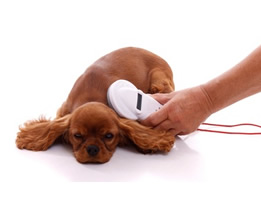Microchipping
Microchipping

A pet microchip is a tiny chip about the size of a grain of rice. It contains a unique code, used as a permanent form of ID and security for your pet. It is an easy way of keeping track of your pet should they wander or get lost.
Once your pet’s been microchipped, you’ll receive confirmation from a registered database containing an ID or reference number, plus your pet’s microchip number.
If your pet goes missing and is later found, it simply needs to be scanned by a device a vet or animal shelter will have. This will recognise the microchip’s unique code and identify your pet.
Dog microchipping
Microchipping your dog is very simple and quick. The chip is usually inserted under the skin of your dog’s neck. It’s done in a matter of seconds, and while it may be slightly uncomfortable for some dogs, others don’t notice it’s happening.
Since 6 April 2016, it’s a legal requirement that all dogs in England, Scotland and Wales be microchipped by the age of eight weeks. Owners who don’t get their dog microchipped and registered face a fine of up to £500.
When you buy or adopt a puppy, your new pet needs to be microchipped before you take it home. Your breeder should pass on the correct microchip paperwork to you.
Cat microchipping
Your cat can be microchipped from early age. We recommend that all cats are microchipped before they’re allowed out for the first time.
While it’s very quick and relatively painless, some owners may ask for their cat to be microchipped while they’re being spayed or neutered so they’re under anaesthetic. This is a common practice, but if you have the opportunity, we recommend you microchip your cat as early as possible, without delay.
As a responsible pet owner, we recommend all cats (even indoor cats) are microchipped – cats are prone to roaming and may go missing. While collars can be easily lost or removed, a chip is very reliable and designed to last a lifetime.
Rabbit microchipping
Rabbits often try to escape and are at risk of getting lost. As they don’t wear collars, a microchip is a good way to make sure they can be identified and returned to you.
Your rabbit should be microchipped as soon as you get them. We will insert the microchip in a quick, relatively painless procedure.
Although you have the option of waiting for your rabbit to be microchipped while they’re being spayed or neutered (so they’re under anaesthetic), this does run the risk of your rabbit not having identification if they manage to escape before then. We recommend you get your rabbit microchipped as early as you possibly can.
Changing your pet’s microchip details
If you move house or change your phone number, you’ll need to contact the database where your pet is registered to change your contact details. If you know the database your pet is registered with, you can simply check your details are up to date by contacting them by phone or online.
If you don’t know the database your pet is microchipped with, take them to your local vet or rescue centre. They’ll be able to do a scan and give you the number.
* Microchip is one of the requirement if you planning to travel with your pet

